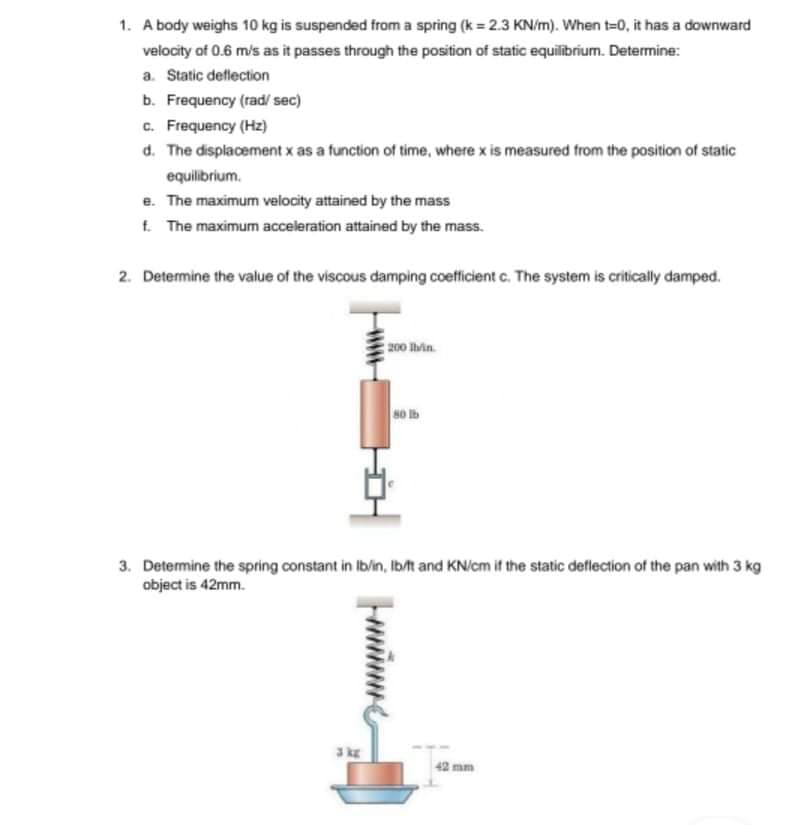1. A body weighs 10 kg is suspended from a spring (k = 2.3 KN/m). When t=0, it has a downward velocity of 0.6 m/s as it passes through the position of static equilibrium. Determine: a. Static deflection b. Frequency (rad/ sec) c. Frequency (Hz) d. The displacement x as a function of time, where x is measured from the position of static equilibrium. e. The maximum velocity attained by the mass f. The maximum acceleration attained by the mass. Th
1. A body weighs 10 kg is suspended from a spring (k = 2.3 KN/m). When t=0, it has a downward velocity of 0.6 m/s as it passes through the position of static equilibrium. Determine: a. Static deflection b. Frequency (rad/ sec) c. Frequency (Hz) d. The displacement x as a function of time, where x is measured from the position of static equilibrium. e. The maximum velocity attained by the mass f. The maximum acceleration attained by the mass. Th
Elements Of Electromagnetics
7th Edition
ISBN:9780190698614
Author:Sadiku, Matthew N. O.
Publisher:Sadiku, Matthew N. O.
ChapterMA: Math Assessment
Section: Chapter Questions
Problem 1.1MA
Related questions
Question
Please answer question number 1.

Transcribed Image Text:1. A body weighs 10 kg is suspended from a spring (k = 2.3 KN/m). When t=0, it has a downward
velocity of 0.6 m/s as it passes through the position of static equilibrium. Determine:
a. Static deflection
b. Frequency (rad/ sec)
c. Frequency (Hz)
d. The displacement x as a function of time, where x is measured from the position of static
equilibrium.
e. The maximum velocity attained by the mass
f. The maximum acceleration attained by the mass.
2. Determine the value of the viscous damping coefficient c. The system is critically damped.
200 hin.
so lb
3. Determine the spring constant in Ib/in, Ib/t and KN/cm if the static deflection of the pan with 3 kg
object is 42mm.
3kE
42 mm
Expert Solution
This question has been solved!
Explore an expertly crafted, step-by-step solution for a thorough understanding of key concepts.
Step by step
Solved in 2 steps with 1 images

Knowledge Booster
Learn more about
Need a deep-dive on the concept behind this application? Look no further. Learn more about this topic, mechanical-engineering and related others by exploring similar questions and additional content below.Recommended textbooks for you

Elements Of Electromagnetics
Mechanical Engineering
ISBN:
9780190698614
Author:
Sadiku, Matthew N. O.
Publisher:
Oxford University Press

Mechanics of Materials (10th Edition)
Mechanical Engineering
ISBN:
9780134319650
Author:
Russell C. Hibbeler
Publisher:
PEARSON

Thermodynamics: An Engineering Approach
Mechanical Engineering
ISBN:
9781259822674
Author:
Yunus A. Cengel Dr., Michael A. Boles
Publisher:
McGraw-Hill Education

Elements Of Electromagnetics
Mechanical Engineering
ISBN:
9780190698614
Author:
Sadiku, Matthew N. O.
Publisher:
Oxford University Press

Mechanics of Materials (10th Edition)
Mechanical Engineering
ISBN:
9780134319650
Author:
Russell C. Hibbeler
Publisher:
PEARSON

Thermodynamics: An Engineering Approach
Mechanical Engineering
ISBN:
9781259822674
Author:
Yunus A. Cengel Dr., Michael A. Boles
Publisher:
McGraw-Hill Education

Control Systems Engineering
Mechanical Engineering
ISBN:
9781118170519
Author:
Norman S. Nise
Publisher:
WILEY

Mechanics of Materials (MindTap Course List)
Mechanical Engineering
ISBN:
9781337093347
Author:
Barry J. Goodno, James M. Gere
Publisher:
Cengage Learning

Engineering Mechanics: Statics
Mechanical Engineering
ISBN:
9781118807330
Author:
James L. Meriam, L. G. Kraige, J. N. Bolton
Publisher:
WILEY